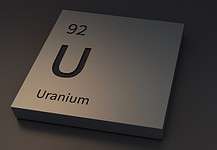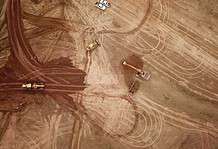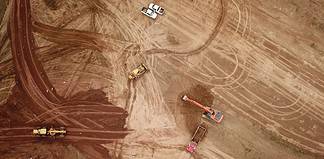CHINA accounts for more than 95 per cent of the world’s output of rare earths, but its increasingly strict controls on output and exports have caused international apprehension as demand for the 17 elements that comprise the rare earth spectrum increases in the face of diminishing supply.
Continuing its mining reputation as ‘the lucky country’, Australia is one of the few areas outside China that has large supplies of rare earth elements. A number of ASX-listed companies have sizable, world-class rare earths deposits, including Lynas Corporation, which is set to commence
production from its Mt Weld project in WA this year, and Northern Minerals.
Rare earths are broken down into three categories – light, medium and heavy – and play a crucial role in the manufacture of many cutting-edge technologies including mobile phones, hybrid cars and wind turbines. In the case of heavy rare earth elements (HREE) such as dysprosium and yttrium, scarcity and a lack of viable substitutes has led to healthier pricing than that of their light or medium counterparts. While market analysts have forecast negligible value increases in light rare earth elements (LREE) such as cerium and lanthanum – which will make up the bulk of Lynas Corporation’s Mt Weld mine production – it is believed that HREEs will continue to command a price premium.
In light of this supply/demand dynamic, the importance of Northern Minerals’ focus on the development of HREEs – with its large and prospective landholding in WA and the NT – cannot be overstated. As projects from other major rare earths players such as Molycorp and Lynas Corporation head into production, Northern Minerals’ point of difference – its dominant distribution of HREEs – makes it arguably the most exciting prospect in the rare earths market outside of China.
The projects Northern Minerals was floated on the ASX in 2006 as Northern Uranium, on the back of a prospective land position straddling the border between WA and the NT, and with a primary focus on uranium exploration. As a result of various regional exploration activities in 2009, the company discovered high-grade HREE in xenotime mineralisation at its Browns Range project.
In March 2010, following its early HREE exploration success, the company decided to focus on rare earth exploration. Northern Minerals then engaged a world-renowned REE expert with more than 20 years of experience in the industry to assist in guiding the company through early
stage activities, including all-important metallurgical work. Highly encouraging results from the company’s maiden rare earth drill program, conducted between June and September 2011, solidified Northern Minerals’ focus on its rare earth portfolio.
“It was over a period of time but there is no question that there was a massive shift in late 2010, and then in 2011 the momentum really built, driven by the exploration and the metallurgical success,” Northern Minerals managing director and chief executive officer George Bauk said. The company’s flagship Browns Range project lies about 140km southeast of the town of Halls Creek in WA’s Tanami Desert. The project includes four established rare earths prospects containing hydrothermal xenotime mineralisation: Wolverine; Gambit; Area 5; and Area 5 North. Xenotime
is a rare earth phosphate mineral and a rich source of high-value HREE such as yttrium and dysprosium. It is also relatively easy and simple to process. Another key feature of the mineralisation at Browns Range is the dominance in HREE, at more than 80 per cent, as well as low levels of uranium and thorium.
Northern Minerals began reverse circulation drilling at Browns Range in late June 2011. By September, 166 holes had been drilled totalling more than 12,000m and assays exhibited extensive HREE mineralisation. Follow-up diamond drilling at the Wolverine Prospect, completed in
late January 2012, indicated extensions of already prolific mineralisation to more than 120m vertical depth. Northern Minerals is now targeting a JORC-compliant resource estimate for Browns Range in the second half of 2012, as well as continuing metallurgical test work to ascertain an economically viable cut-off grade for the project’s deposits. “Wolverine has just been a standout,” Mr Bauk said.
“It has great width, continuity and simplicity and has been a focus of our exploration activities to date. Gambit is also very exciting, but we just have work to do on that. “We have the mineralisation success at Area 5 and Area 5 North; the results have not been as exciting as Wolverine, but they will be forming part of that scenario somewhere along the line. We also have other targets that we haven’t even addressed yet.” In addition to Browns Range, Northern Minerals also has an option agreement in place with private company Arnhem Resources, providing it with the exclusive right to purchase a 100 per cent interest in the John Galt rare earths project in the east Kimberley region of WA. HREE mineralisation was discovered at the John Galt project in 1971 following an airborne gamma spectrometer survey. Follow-up ground radiometric surveys, sampling and trenching identified xenotime-hosted mineralisation at three different zones about 600m apart – Main Zone, Gadolin and Ytterby – with rock chip sampling returning assays containing up to 53.5 per cent total rare earth oxide (TREO). Metallurgical characterisation test work at John Galt indicated very good metallurgical recoveries of more than 90 per cent – higher than Browns Range – with concentrate grades of more than 40 per cent TREO.
In January, Northern Minerals announced that rock chips taken from John Galt in November 2011 had returned results of up to 42 per cent TREO, including 3.68 per cent dysprosium. Studies of these rock chip samples confirmed the similarity of the mineralisation style with that of Browns
Range, along with a similar dominance of high value HREE. The latest rock chip sampling program also identified a potential early stage production target in the scree material at John Galt, which returned some of the highest-grade HREE results. “It provides us with a huge number of opportunities that we are working through,” Mr Bauk said.
“Our initial focus was around the known mineralisation that was discovered in the 1970s, and so when we went out and saw this scree there was no literature to tell us that it was there, and to get up to 42 per cent was fantastic.
“[John Galt] could very well be a small resource that can be processed very quickly into production. We don’t know the extent of it; we have guesstimates internally, but we still have to go through the relevant process to understand volumes and grade. Another thing is the metallurgy has been a significant windfall for us in term of the simplicity.”
The high occurrence of HREEs at Northern Minerals’ projects can be attributed to deposits of unique xenotime mineralisation. Xenotime is easier and cheaper to separate and process than many REE deposits and, importantly, analysis by Northern Minerals has shown that a significant concentrate grade of 40 per cent is achievable thanks to the unique quality and purity of its projects’ mineralisation. Mr Bauk said that Northern Minerals anticipated that this would give it a distinct advantage in the rare earths markets as the company moved toward targeted first production in 2015. “The way that earths are consumed is not the way that it is found in the ground. There is always this challenge to balance your output to the demand for each individual element,” he said.
“The two other [rare earths] projects in development, from Lynas Corporation and Molycorp, get close to being able to balance the market in terms of the demand for light rare earths outside of China. “That gives us the opportunity to resolve some of the other elements. Lynas and Molycorp are going to have an impact on six to eight of the 17 elements that make up rare earths, but there are going to be a number of elements – in particular the heavies – that they can’t resolve because they don’t have the distribution within their resources.”
Mr Bauk described Northern Minerals as “an enabler” that he said was looking to “complete the picture outside of China”. Underpinning Northern Minerals’ rare earths projects is their proximity to existing infrastructure. This includes access to sealed roads, port facilities at Wyndam, and
fresh water supplies already used by other projects in the region.
As xenotime mineralisation is relatively easy to separate, the company will enjoy low capital and operating costs. Its strategy is to build a $90 million concentrator at Browns Range by the end of 2014, with commencement of heavy rare earth oxide (HREO) in concentrate from 2015. Bateman Engineering has been appointed to coordinate metallurgical studies and complete scoping capital and operating cost estimates.
Mr Bauk said that Northern Minerals was confident in its capacity to meet its 2015 production target.
“If you look at what we have done even in the last couple of months – we have started the JORC resource diamond drilling, the environmental studies, with the first stages of work on site started in early January – we are ticking every box as planned, and that is what we are working towards: a 2015 production scenario,” he said.
By Reuben Adams





































